
Castlevania for the Nintendo 64 (commonly known as "Castlevania 64") has in recent times gained the reputation as being somewhat of a black sheep in the Castlevania series. Even official sources flip-flop on whether it still counts as part of the official Castlevania timeline (when Konami still cared about Castlevania anyway). Nevertheless it's one of my favourite games. Yes, it suffers a bit from being an early Nintendo 64 title, it sometimes tries to be a bit too experimental for its own good, and the Nintendo 64 controller doesn't help the game much, but still I think it's a solid title (a lot of control issues would have been solved if it were just rereleased for Virtual Console).
Important note: this is supposed to be an analysis, not a review. Therefore I will not mind bringing up spoilers if they are relevant. Proceed with caution if you have yet to play this game and do not want to be spoiled.
The Castle of Hell
Castlevania 64 (1999)
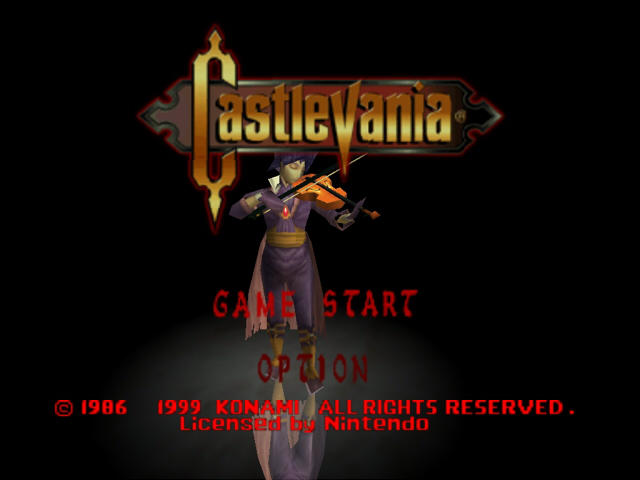
- 0. Personal History
- 1. Story and Setting
- 2. Main Characters
- 3. Level Select: Stage 3 Villa
- 4. Castlevania, Vampires and Dualism
- 5. Links & References
0. Personal History
Back in 1999 I didn't know anything about Castlevania, but it looked interesting and I was convinced to buy it after the store clerk mentioned it was "like Zelda" (which confused me after playing it since it barely resembled it at all, but in retrospect he probably just meant that the franchise has been around for about as long and has been similarly acclaimed). At first I didn't like it all that much, mainly because I was 11 and I had just bought my first horror title, but very soon I came to adore the creepy atmosphere, the interesting characters, the epic music that typifies Castlevania and yes, even the gameplay (although as I said, playing it on the actual N64 makes it a struggle against the controller).
1. Story and Setting

The story takes place in Wallachia, Transylvania in 1852. Dracula has awoken after a century of being locked away (later releases such as Order of Ecclesia (18??) and Circle of the Moon (1830) would reduce it to mere decades). Two heroes descended from the legendary Belmont and Belnades clans take it on themselves to once again rid the world of Dracula's influence.
The Castlevania series functions as an extended universe to Bram Stoker's novel Dracula 1, which makes its 1852 setting especially interesting as it is a mere 40 years before the count's return in the novel. Unfortunately there's very little to connect this particular game to the novel, except perhaps the Belmont clan having a reduced presence in this century due to being split up into clans with different surnames. In that way Reinhardt Schneider might make it more digestible to have the novel's Quincy Morris be part of the Belmont lineage.
Some anachronisms exist within the setting, the most goofy of which is the giant skeleton boss of the first stage being accompanied by two smaller skeletons riding on motorcycles. Certain areas of the Castle Center and the Tower of Science itself reveal Dracula to have access to advanced science for the time period, which doesn't seem all that out of place considering his vast powers and connection to demonic forces.
Also there must be something odd in Wallachia's water anyway because four of the major characters, including Dracula himself, have blue hair (Carrie's cousin has green hair).
2. Main Characters
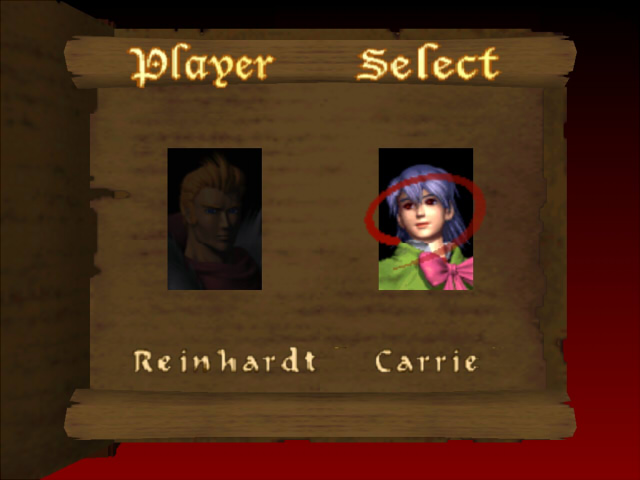
We have the option of 2 playable protagonists: Reinhardt Schneider, a descendant of the Belmont clan who dedicated themselves to defeating Dracula, and Carrie Fernandez, a descendant of the witch Sypha Belnades (In Japan they have the same surname) from Castlevania III: Dracula's Curse.
Most of the game is the same no matter which character you pick, except they'll interact differently with certain characters, they'll have a different personal nemesis and 3 of the 10 stages will differ (Reinhardt will visit Tunnel, Duel Tower and Tower of Execution, while Carrie visits Underground Waterway, Tower of Science and Tower of Sorcery).
On the gameplay front I found Reinhardt and his whip rather boring and it doesn't work as smoothly in 3D as it did in the older 2D games. Carrie and her homing magic bullet make combat more manageable, as you can properly focus on evading enemy attacks rather than struggle to aim your whip. Because of that my perspective of the game is heavily skewed towards it being Carrie's game rather than Reinhardt's. Reinhardt does have the more interesting Dracula fights as the game maintains the need to specifically hit his head, which requires some strategic manoeuvring from Reinhardt.
An interesting difference between these two heroes are their attitudes in how they go about their quest. Reinhardt, despite being the classic hero archetype, has clear doubts about his ability to live up to the legacy of his Belmont ancestors. Meanwhile 12-year old Carrie storms Dracula's castle with the full conviction that she has the power to destroy Dracula. This is even reflected in their quotes as the game starts up (and their only pieces of voiced dialogue):
"Courage, don't leave me."
- Reinhardt Schneider
"Whatever awaits, I have no regrets."
- Carrie Fernandez
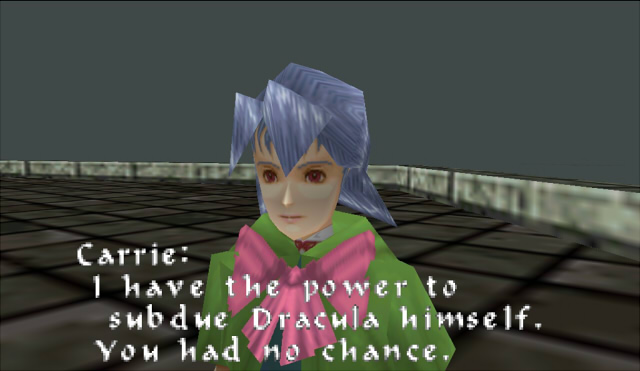
Only a few simple words, but they nevertheless reveal a great deal about their respective speaker. Reinhardt is clearly having doubts about himself, which are feelings Carrie doesn't share. In Carrie's quest it becomes a recurring theme in her dialogue to reflect her absolute conviction that she's powerful enough to defeat Dracula. She even mocks her nemesis Actrise for being a mere pawn to delay Carrie from reaching the Count.
Their difference in personality is also reflected in the challenges they face. On top of merely having to deal with the general quest of having to kill the resurrected Dracula, at the various points where their respective storylines differ, the villains start playing on our protagonists' personal doubts and fears. Reinhardt, doubting his ability to live up to his ancestors' legacy, is presented with a damsel in distress whom he can't possibly save. His personal demon is presented in the form of Dracula's right hand and series regular Death. Carrie, having had to deal with losing her family, is forced to put a vampirized relative out of her misery (a cousin, but originally supposed to be Sypha Belnades herself). And while Carrie has lost her loving stepmother who died protecting her, her personal demon comes in the form Actrise, a woman who sacrificed her own child for eternal beauty.
A girl with magical powers being named 'Carrie' of course brings to mind Stephen King. I do not think this is accidental as several elements seem obviously inspired by the 1979 'Salem's Lot miniseries (such as the way vampires disappear into mist, and the generic male vampire looks like Barlow with exagerated features)
3. Level Select: Stage 3 Villa
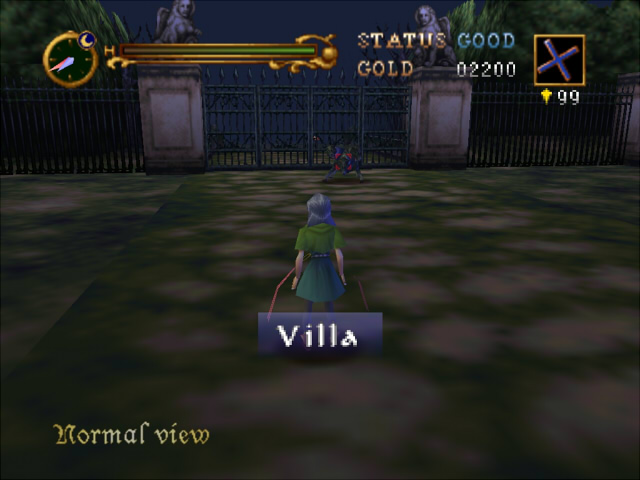
It would take far too much effort to analyse all the stages in detail, so for now I'll stick to just one. By far the best remembered level for most people (including me) is the Villa. After the approach through the Forest of Silence and breaching the Castle Wall, players are immediately attacked by a series of Cerberus enemies (3 headed dogs, some of which can breathe fire) that guard the gates to the Villa. Once inside those gates, you are greeted with nothing but the serene sound of the fountain in the middle of the front garden with the face of the villa behind it (the outside is supposedly based on the château of Azay-le-Rideau. Before a moment of peace can set in however, you'll soon realize the garden is in fact a graveyard holding the former inhabitants: the Oldrey family. Though a minor nuisance, it turns out their ghosts aren't particularly fond of intruders.

Once inside you find yourself inside a hall that looks suspiciously similar to the Spencer Mansion from Resident Evil 1. Before you manage to explore anything, a man-sized creature crawls across the walls and jumps right in front of you, revealing the first of the game's many vampires (Castlevania: Legacy of Darkness reveals this one to be Master J.A. Oldrey himself, who has been haunting his residence for 8 years). This was my first experience with a horror game as a child, and this scene left the biggest impression. Every time I played the game after, I dreaded this particular moment. The vampires in this game just look absolutely terrifying.
The previous stages weren't entirely linear, but this one changes things up by requiring exploration and figuring things out based on characters giving clues. Combined with the setting itself, I think it's fairly safe to say the game designers did indeed take notes from Resident Evil. On top of that there's a surprising amount of detail spent on making this place actually feel like a luxurious, though haunted by vampires and demons, villa. The walls are lined with art, including portraits of previous residents and the furniture is surprisingly elaborate for a Nintendo 64 game.
This stage introduces us to most of the game's important characters: fellow vampire hunter Charlie Vincent, the noble vampire Rosa who has retained her human soul, the village child Malus and the demon salesman Renon. All of whom are interesting in their own right.

Charlie Vincent is likely the first non-enemy character you encounter in the entire game (outside of being briefly taunted by Dracula himself at the Castle Wall). He appears unexpectedly when you open a door in the bedroom, waving a cross 2 in your face to determine whether you are one of Dracula's henchmen or not.
He is presented as the self-professed expert vampire hunter who to us comes across as being in way over his head. We are the descendants of the Belmont/Belnades clan after all while this guy is an unknown. He carries around a stake and multiple crosses (including a giant one on his back), so while obviously being prepared, he comes across as rather foolish. This image is not helped by his general look (although with an added mustache) and name 'Charlie Vincent' calling to mind Peter Vincent (Roddy McDowall's character) from Fright Night, who is an actor who plays a fictional legendary vampire hunter but freaks out when confronted with actual vampires. It thus comes as a surprise when later it turns out he is in fact instrumental in revealing the true identity of Dracula (in the good ending at least, which can be triggered by spending less than 4 in-game days reaching the Castle Keep).
Following Vincent's clue of spotting a young woman at dawn, you can, at dawn, encounter Rosa who has allegedly come to water the garden's "white" roses. Something is clearly wrong here because the roses are obviously red. Then it turns out the water from her watering pot is actually blood, and there was apparently so much of it that it stained all the white roses red.
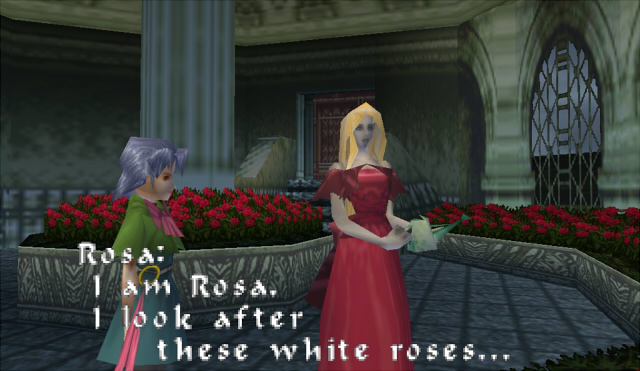
Surprise! Rosa is one of the villa's vampires. Unlike any of the other vampires however, she's not at all hostile to the player character and surprisingly compassionate. She urges the player character to leave the castle, but decides to help out when they declare they can't do so until Dracula has been stopped. In Carrie's story, this is the only time we ever encounter her. In Reinhardt's story however, she's a recurring character and becomes his love interest. There we learn that Rosa has managed to maintain her human soul despite being turned. Nevertheless Death uses her as a pawn against Reinhardt and thus she turns into a tragic villain we have to fight as a boss at the end of the Castle Center (the aforementioned damsel in distress Reinhardt can't save).
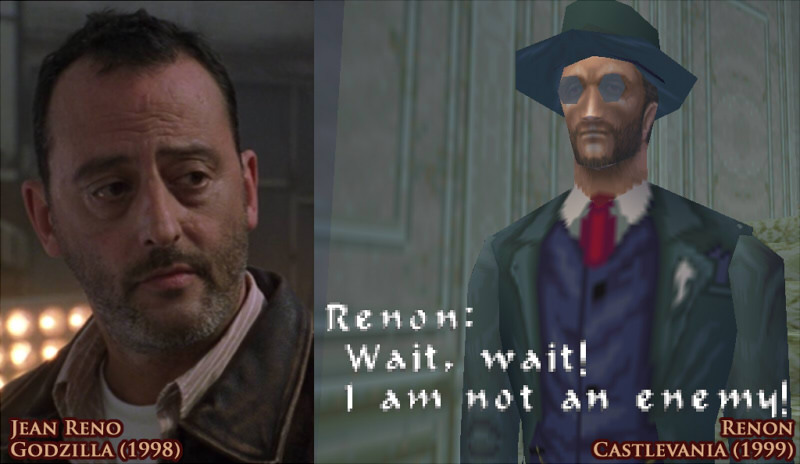
Descending down the stair that lead to the maze garden, you find a mysterious scroll on the ground. A man who introduces himself as a demon named Renon (who for some reason bears a striking resemblance to French actor Jean Reno) appears and explains to us that he sells useful items to adventurers such as us because "one needs gold even in hell these days". He's the game's store who can be summoned from scrolls such as the one you've just found.
The one detail he neglects to mention however is that the small print in the contract specifies that spending more than 30,000 gold in his store means he gets to claim your soul as well, meaning abuse of his services punishes you by adding an extra boss in the Castle Keep before you get to face Dracula. Luckily this limit is so lenient that it's unlikely you'll ever encounter it accidentally. I had to play the game multiple times and go out of my way to collect as much gold as possible to trigger his boss fight. It's as if the real challenge was to find all the secret gold stashes.
Then comes the maze garden itself, which quickly becomes the most intense part of the game. After wandering around for a bit, you encounter a child abducted from the village named Malus.
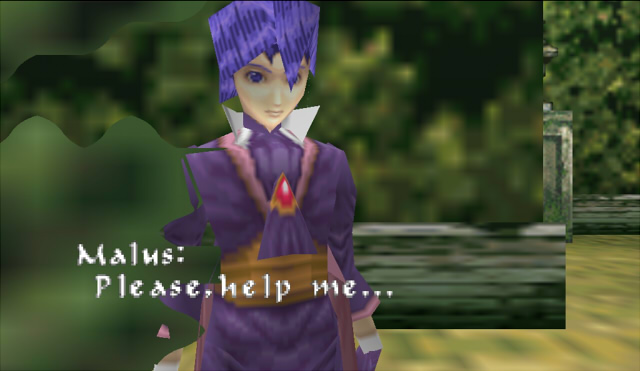
After a short introduction where he fails to remember what exactly happened to him to end up in this horrible place, you are suddenly attacked by two stone dogs you may remember as the statues in front of the maze. As Malus runs away in panic and the dogs give chase, you come face to face with the gardener: a giant Frankenstein's monster with a chainsaw for a right arm. Worse of all, he's invincible and can only be temporarily delayed, never defeated. The only thing you can do is try to keep up with Malus while you have to dodge all three enemies at once. Then the little bugger crawls under a hedge too low for us, forcing us to backtrack to find a way around and likely having to directly dodge the gardener coming right for us.
Malus having escaped, there's only one thing left to do: head towards the stage's dual bosses in the crypt. At first the crypt seems empty. Once you investigate the empty coffin at its opposite side, suddenly a corpse drops from the ceiling. Master Oldrey, the vampire we encountered at the start of the stage, was enjoying his meal and has now decided to make you his main dish. He's not all that much harder than previous vampires, he just has more health, dodges a lot quicker and can fire projectiles at you. Once you defeat him however, his previous victim has had enough time to turn herself.

4. Castlevania, Vampires and Dualism
Castlevania as a series based on Bram Stoker's vampire Dracula inherently introduces Christian elements and imagery into the game world, superficial as they may be. Traditionally it is thought vampires do not cast a reflection because they lack a soul. Indeed in the Villa stage we have a cutscene where a seemingly ordinary, though clearly deranged, villager is revealed to be a vampire in disguise because he doesn't appear in a nearby mirror. It's even a rather effective jump-scare, even though we can see it coming from miles away.
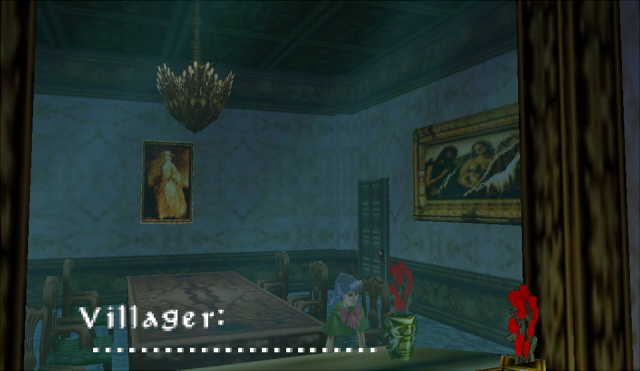
We also have several characters, especially demonic villains who are likely authorities on the subject, who comment on souls and the harvesting thereof. Like a lot of vampire fiction, Castlevania thus maintains a view of the mind-body that is dualistic in nature.
Dualism is essentially the idea that there's a difference between the mind and the brain, or the soul and our bodies. It is an idea closely associated with René Descartes (1596-1650), who believed the mind has a two-way relationship with the body through the pineal gland in the brain, but has since fallen out of style, largely because it is essentially the 'God did it' of neurobiology and thus a scientific stopping point of investigation. Finding an explanation of what consciousness is and how it came about is to this day an enormous mindscrew (excuse the pun), but it is a fairly safe assumption that 'we' aren't a metaphorical homunculus operating a body from inside the brain (or, a metaphysical player operating a real world player character).
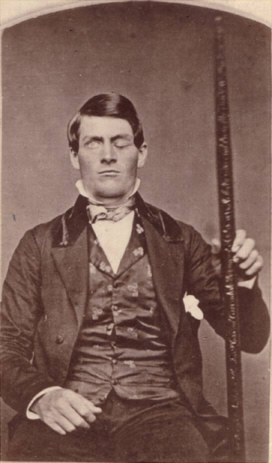
An often-cited example that cast doubt over dualism is the case of Phineas Gage (1823-1860), an American railroad construction foreman who because of an accident in 1848 had a large iron rod driven through his skull, destroying parts of his brain. Gage amazingly survived but his personality and behaviour saw drastic changes. This is of course odd if the self is immaterial to the brain. It should be noted however that the body of facts regarding the "American Crowbar Case" is surprisingly slim for one so noteworthy in neurology. Later evidence (such as the pictures of him discovered in 2009 and 2010) revealed that Gage's sudden personality change did in fact level out and he recovered his social abilities later in life (which on the surface to me sounds like he makes an amazing example of Neuroplasticity in action).
Back to Castlevania. The existence of Rosa makes things interesting. Here we have a vampire who has somehow maintained her human soul despite having been turned. This raises a couple of questions. Would she appear in a mirror despite being a vampire? What gives the other scheming and articulate vampires their intelligence? Perhaps the lesser enemies are simply driven by basal desires while Dracula's inner circle consists of turned humans who like Rosa have their souls intact but who simply were just that evil. Carrie's nemesis Actrise murdering 100 children, including her own, to attain his favor certainly makes a case for that possibility. Where this doesn't hold up is with Master J.A. Oldrey in the Legacy of Darkness version of the game, who was described by his wife as a good man before he was turned into a decidedly evil vampire but who retains his intelligence.
What then of the count himself? In the usual Castlevania game, he is merely resurrected after having been slain by the previous Belmont. This game however has it as an actual plot twist that he hasn't been resurrected, but has been outright reincarnated (3). On the duality scale, clearly he must still have his soul intact (though warped due to the events of Lament of Innocence and Symphony of the Night) if he is subjected to reincarnation.

In this game it is actually possible for the player characters themselves to be turned into vampires. One of the tactics enemy vampires will employ is that they will try to get close in order to suck Reinhardt or Carrie's blood. If not fought off rapidly enough, their status will change from 'Good' to 'Vamp'. This status effect will disable the character's main attack and unless cured by an item known as 'Purifying', at the stroke of midnight the character will turn into a vampire themselves (unless bitten less than an hour before midnight, then you are afforded an extra day). At this point the screen goes black and the player is booted to the Game Over screen. In a meta sense, you could argue this means the player is the character's "soul" and the process of turning into a vampire severs that connection. Without our moral guidance, Reinhardt or Carrie are now just mindless monsters themselves.
But that's getting a bit too deep into a goofy horror game about blue-haired anime vampires.
Notes and citations
-
Notes
- 1. Quincy Morris from Bram Stoker's Dracula is stated in the Castlevania games to be a relative of the Belmont clan. His son (John Morris) and grandson (Jonathan Morris) are playable characters in Bloodlines and Portrait of Ruin respectively.
- 2. I wrote this entire paragraph with "crucifix" in place of "cross" before I learned it's technically only a crucifix when it consists of a cross and a corpus (the body of Jesus Christ). (https://en.wikipedia.org/wiki/Crucifix)
- 3. He is reincarnated again as Soma Cruz in the games Aria of Sorrow (2003) and Dawn of Sorrow (2005), perhaps one of the reasons why Castlevania 64 has a dubious place in the timeline, as it rather conflicts with the nature of reincarnation in those games.
-
Sources and citations
- https://castlevania.fandom.com/wiki/Castlevania_Wiki
- Dennett, Daniel - Consciousness Explained (1991)
- Doidge, Norman - The Brain That Changes Itself (2007)
- Kaku, Michio - The Future of the Mind (2014)
-
Images from
-
- Castlevania, Konami (1999)
- Wikimedia Commons - Phineas Gage
